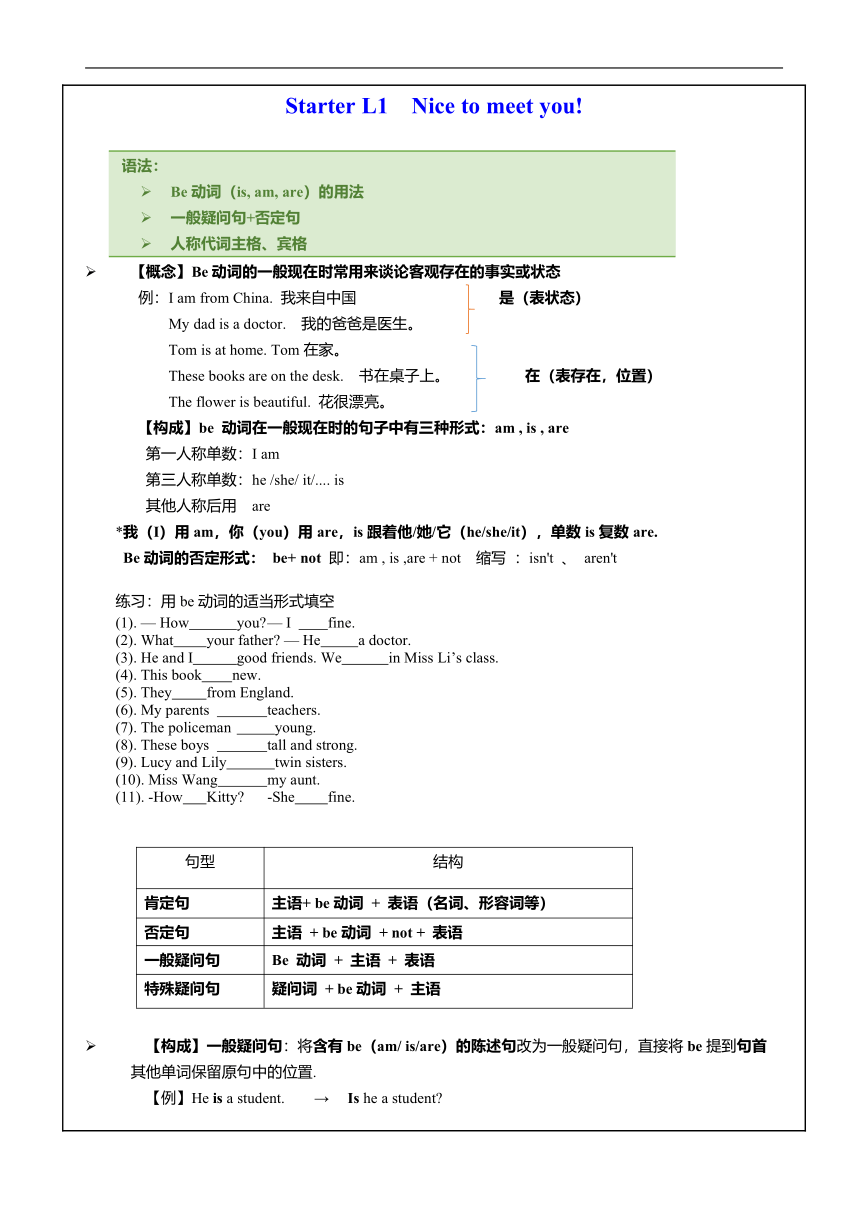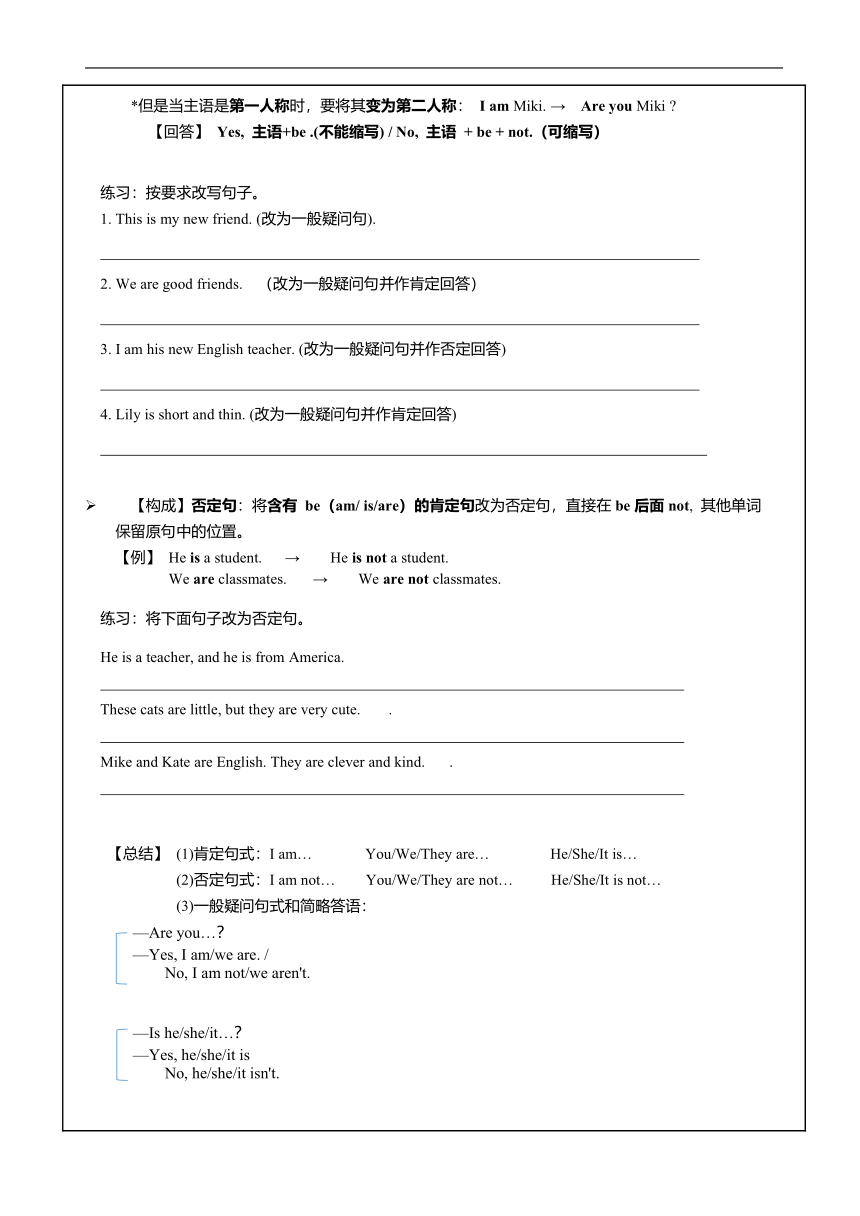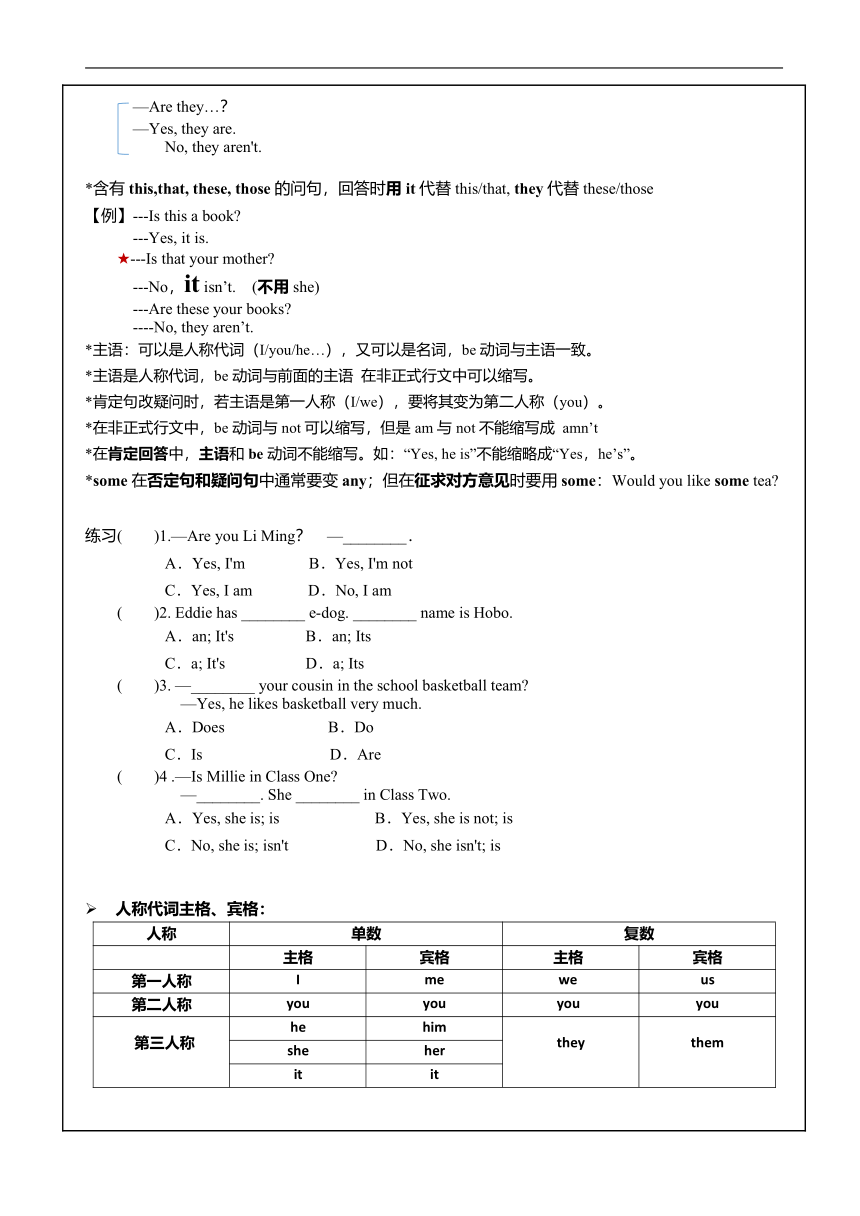牛津译林版英语预备课程 starter Lesson 1 Nice to meet you ! 学案 (无答案)
文档属性
| 名称 | 牛津译林版英语预备课程 starter Lesson 1 Nice to meet you ! 学案 (无答案) |  | |
| 格式 | docx | ||
| 文件大小 | 37.8KB | ||
| 资源类型 | 教案 | ||
| 版本资源 | 牛津译林版 | ||
| 科目 | 英语 | ||
| 更新时间 | 2021-09-23 09:39:14 | ||
图片预览



文档简介
Starter
L1
Nice
to
meet
you!
语法:
Be动词(is,
am,
are)的用法
一般疑问句+否定句
人称代词主格、宾格
【概念】Be动词的一般现在时常用来谈论客观存在的事实或状态
例:I
am
from
China.
我来自中国
是(表状态)
My
dad
is
a
doctor.
我的爸爸是医生。
Tom
is
at
home.
Tom在家。
These
books
are
on
the
desk.
书在桌子上。
在(表存在,位置)
The
flower
is
beautiful.
花很漂亮。
【构成】be
动词在一般现在时的句子中有三种形式:am
,
is
,
are
第一人称单数:I
am
第三人称单数:he
/she/
it/....
is
其他人称后用
are
我(I)用am,你(you)用are,is跟着他/她/它(he/she/it),单数is复数are.
Be动词的否定形式:
be+
not
即:am
,
is
,are
+
not
缩写
:isn't
、
aren't
练习:用be动词的适当形式填空
(1).
—
How
you?
—
I
fine.
(2).
What
your
father?
—
He
a
doctor.
(3).
He
and
I
good
friends.
We
in
Miss
Li’s
class.
(4).
This
book
new.
(5).
They
from
England.
(6).
My
parents
teachers.
(7).
The
policeman
young.
(8).
These
boys
tall
and
strong.
(9).
Lucy
and
Lily
twin
sisters.
(10).
Miss
Wang
my
aunt.
(11).
-How
Kitty?
-She
fine.
句型
结构
肯定句
主语+
be动词
+
表语(名词、形容词等)
否定句
主语
+
be动词
+
not
+
表语
一般疑问句
Be
动词
+
主语
+
表语
特殊疑问句
疑问词
+
be动词
+
主语
【构成】一般疑问句:将含有be(am/
is/are)的陈述句改为一般疑问句,直接将be提到句首
其他单词保留原句中的位置.
【例】He
is
a
student.
→
Is
he
a
student?
但是当主语是第一人称时,要将其变为第二人称:
I
am
Miki.
→
Are
you
Miki
?
【回答】
Yes,
主语+be
.(不能缩写)
/
No,
主语
+
be
+
not.(可缩写)
练习:按要求改写句子。
1.
This
is
my
new
friend.
(改为一般疑问句).
2.
We
are
good
friends.
(改为一般疑问句并作肯定回答)
3.
I
am
his
new
English
teacher.
(改为一般疑问句并作否定回答)
4.
Lily
is
short
and
thin.
(改为一般疑问句并作肯定回答)
【构成】否定句:将含有
be(am/
is/are)的肯定句改为否定句,直接在be后面not,
其他单词
保留原句中的位置。
【例】
He
is
a
student.
→
He
is
not
a
student.
We
are
classmates.
→
We
are
not
classmates.
练习:将下面句子改为否定句。
He
is
a
teacher,
and
he
is
from
America.
These
cats
are
little,
but
they
are
very
cute.
.
Mike
and
Kate
are
English.
They
are
clever
and
kind.
.
【总结】
(1)肯定句式:I
am…
You/We/They
are…
He/She/It
is…
(2)否定句式:I
am
not…
You/We/They
are
not…
He/She/It
is
not…
(3)一般疑问句式和简略答语:
—Are
you…?
—Yes,
I
am/we
are.
/
No,
I
am
not/we
aren't.
—Is
he/she/it…?
—Yes,
he/she/it
is
No,
he/she/it
isn't.
—Are
they…?
—Yes,
they
are.
No,
they
aren't.
含有this,that,
these,
those的问句,回答时用it代替this/that,
they代替these/those
【例】---Is
this
a
book?
---Yes,
it
is.
★---Is
that
your
mother?
---No,it
isn’t.
(不用she)
---Are
these
your
books?
----No,
they
aren’t.
主语:可以是人称代词(I/you/he…),又可以是名词,be动词与主语一致。
主语是人称代词,be动词与前面的主语
在非正式行文中可以缩写。
肯定句改疑问时,若主语是第一人称(I/we),要将其变为第二人称(you)。
在非正式行文中,be动词与not可以缩写,但是am与not不能缩写成
amn’t
在肯定回答中,主语和be动词不能缩写。如:“Yes,
he
is”不能缩略成“Yes,he’s”。
some在否定句和疑问句中通常要变any;但在征求对方意见时要用some:Would
you
like
some
tea?
练习( )1.—Are
you
Li
Ming? —________.
A.Yes,
I'm
B.Yes,
I'm
not
C.Yes,
I
am
D.No,
I
am
( )2.
Eddie
has
________
e?dog.
________
name
is
Hobo.
A.an;
It's
B.an;
Its
C.a;
It's
D.a;
Its
( )3.
—________
your
cousin
in
the
school
basketball
team?
—Yes,
he
likes
basketball
very
much.
A.Does
B.Do
C.Is
D.Are
( )4
.—Is
Millie
in
Class
One?
—________.
She
________
in
Class
Two.
A.Yes,
she
is;
is
B.Yes,
she
is
not;
is
C.No,
she
is;
isn't
D.No,
she
isn't;
is
人称代词主格、宾格:
人称
单数
复数
主格
宾格
主格
宾格
第一人称
I
me
we
us
第二人称
you
you
you
you
第三人称
he
him
they
them
she
her
it
it
练习:
用正确的人称代词填空:
(1).
—
Is
your
mother
fine
today?
—
Yes,
is.
(2).
Andy
is
Millie’s
cousin.
is
tall
and
strong.
(3).
Lucy’s
parents
are
teachers.
are
at
school.
(4).
All
of
my
new
classmates
are
polite.
are
good
friends.
(5).
—
Who
is
the
boy
over
there?
-
is
my
brother.
(6).
Mimi
is
a
cat.
is
two
years
old.
(7).
—
Are
from
China?
—
Yes,
I
am.
在一个句子中,人称代词做主语,就用主格;作宾语,就用宾格——用于动词或介词后。
【概念】
主语:表示句子中所说的是“什么人”或“什么事物”。
例:Lucy
is
an
American
girl.
She
often
goes
to
school
by
bike.
The
cat
is
black.
Our
classroom
is
big.
【概念】宾语:表示动作、行为的对象。
例:He
likes
her.
I
love
China.
She
drinks
some
soup.
Miss
Gao
teaches
us.
练习:
标出下列句子的主语及宾语。
1.
I
have
a
cat.
2.
I
often
play
with
it.
3.
It
is
cute.
4.
Let
me
tell
you
about
my
school.
重点句型:
Hi
/
Hello
/
How
do
you
do.
(问候用语)
Good
morning/
afternoon/evening
/
night
Good
bye.
/
Bye.
This
is
…
英语中,介绍某人时,常用
This
is
…或That
is
…而不直接说
He
is…
或
She
is…,
注意:
this
is
不能缩写成为
this’s)
例如:This
is
Simon
and
that
is
Linda.
这是
Simon,
那是
Linda。
How
+
be
+
sb
常用于询问身体情况。
例如:How
are
you?
你怎么样?;
How
is
he?
他怎么样?
回答】如果表达
“很好,还不错”
,回答常用
Fine/
I’m
fine.
如果表达
“不好”
,可以用
Not
well.
Nice
to
meet
you.
/
Nice
to
see
you.
见到你很高兴
【回答】Nice
to
meet
you
too.
/
Nice
to
see
you
too.
见到你也很高兴。
Are
you
…?
你是…吗?
【回答】Yes,
I
am.
/
No,
I’m
not.
是的,我是。/
不,我不是。
What’s
your
name?
你叫什么名字?
【回答】
I
am…/
My
name
is
…/
+姓名.
我是….
例如:I
am
Miki.
/
My
name
is
Miki.
/
Miki.
Let
sb
do
sth
让某人做某事,用来表示建议或提出要求。(sb
宾格;动词要用原形。)
例如:
Let
us
read.
让我们阅读。
Let
him
swim.
让他游泳。
8重点单词短语:
have
a
look
看一看;
have
a
look
at
sth
看一看…
【例】have
a
look
at
the
dog
看一看这只狗
tall
and
strong
又高又壮
【拓】short
and
thin
又矮又瘦
clever
and
kind
聪明又善良;
【例】He
is
tall
and
strong.
他又高又瘦。
We
are
clever
and
kind.我们聪明又善良。
Mr.
先生(所有男性)
Mrs.
夫人/太太(已婚)
Miss
小姐(未婚)
Ms.
女士(不知道已婚还是未婚)表达方式
称谓+姓(首字母都要大写):
Mr.
Wang
王先生;Mrs.
Li
李夫人;Aunt
Gao
高阿姨;Uncle
Chen
陈叔叔
【拓】1.
family
name
是姓。在英文中置于最后,
例如:Jone
Smith,Simith是姓。但在英文中姓不能单独使用,
通常前面要加上Mr./Mrs./Miss/Ms.
2.
first
name是名字,在英文中,通常放在最前面,例如:Lily
White
,Lily就是first
name,是她的名字.在英文中,名字是可以单独叫的,比如你可以喊她“Lily”.跟“小丽”一样。
3.
last
name可以理解为与family
name是一样的,是姓,因为放在最后,所以叫last
name。
4.
middle
name
与中文相反,在英文中,自己的名字放在最前面,姓放在最后,他们习惯在中间罗列一些爷爷,或者是太爷爷的名字,来纪念他们。这些放在中间的祖辈的名字就middle
name。这个可以有很多.可以不唯一。
【例】比如Jack
Martain
Green。Jack
是他自己的名字first
name,Martain是爷爷的名字middle
name,Green
是姓family
name
或者last
name.
指示代词:this
这个;that
那个;these
这些;those
那些。
I’m
=
I
am
我是;I’m
not
=
I
am
not
我不是
You’re
=
You
are
你/你们是
;
You’re
not
=
You
are
not
你/你们不是
He’s
=
He
is
他是
;
He’s
not
=
He
isn’t
他不是
She’s
=
She
is
她是
;
She’s
not
=
She
isn’t
她不是
We’re
=
We
are
我们是;We’re
not
=We
aren’t
我们不是
They’re
=
They
are
他们是
;
They’re
not
=
They
aren’t
他们不是
It’s
=
It
is
它是;It’s
not
=
It
isn’t
它不是
in
one’s
class
在某人班上
【例】Andy
is
in
our
class
and
we’re
cousins.
I
see.
=
I
know/understand.
我明白/知道了。
All
my
classmates…
我的同学全都…
All修饰主语,放在主语或行为动词之前,be动词之后;如果主语是代词,只能是代词+all的形式;若be在最后,all要放在be之前,并带强调意味。
【例】
1.
All
the
boys
study
well.
=
The
boys
all
study
well.
2.
They
are
all
boys.
=
All
of
them
are
boys.
3.
-
Who’s
late
for
class
today?
-
Luke,
Mike,
Will
and
Dustin.
They
all
are.
注意:
all
表示三个或三个以上
【拓】both.
两者,两者都
both…and…
不仅...而且...;...和...都...
句子中的位置:
1.
一般在放在be动词(is/am/are),情态动词
(can/would/should)
和
助动词
(do/does/did)
之后,动词之前。
【例】They
are
both
teachers.
他们俩都是老师。
We
can
both
swim.
我们俩都会游泳。
They
are
both
good
students.
他们都是好学生。
2.
可直接作形容词修饰名词,如:Both
brothers
are
clever.
但当名词前有限定词(the/a/an等),只能用both
of:Both
of
the
brothers
are
clever.
L1
Nice
to
meet
you!
语法:
Be动词(is,
am,
are)的用法
一般疑问句+否定句
人称代词主格、宾格
【概念】Be动词的一般现在时常用来谈论客观存在的事实或状态
例:I
am
from
China.
我来自中国
是(表状态)
My
dad
is
a
doctor.
我的爸爸是医生。
Tom
is
at
home.
Tom在家。
These
books
are
on
the
desk.
书在桌子上。
在(表存在,位置)
The
flower
is
beautiful.
花很漂亮。
【构成】be
动词在一般现在时的句子中有三种形式:am
,
is
,
are
第一人称单数:I
am
第三人称单数:he
/she/
it/....
is
其他人称后用
are
我(I)用am,你(you)用are,is跟着他/她/它(he/she/it),单数is复数are.
Be动词的否定形式:
be+
not
即:am
,
is
,are
+
not
缩写
:isn't
、
aren't
练习:用be动词的适当形式填空
(1).
—
How
you?
—
I
fine.
(2).
What
your
father?
—
He
a
doctor.
(3).
He
and
I
good
friends.
We
in
Miss
Li’s
class.
(4).
This
book
new.
(5).
They
from
England.
(6).
My
parents
teachers.
(7).
The
policeman
young.
(8).
These
boys
tall
and
strong.
(9).
Lucy
and
Lily
twin
sisters.
(10).
Miss
Wang
my
aunt.
(11).
-How
Kitty?
-She
fine.
句型
结构
肯定句
主语+
be动词
+
表语(名词、形容词等)
否定句
主语
+
be动词
+
not
+
表语
一般疑问句
Be
动词
+
主语
+
表语
特殊疑问句
疑问词
+
be动词
+
主语
【构成】一般疑问句:将含有be(am/
is/are)的陈述句改为一般疑问句,直接将be提到句首
其他单词保留原句中的位置.
【例】He
is
a
student.
→
Is
he
a
student?
但是当主语是第一人称时,要将其变为第二人称:
I
am
Miki.
→
Are
you
Miki
?
【回答】
Yes,
主语+be
.(不能缩写)
/
No,
主语
+
be
+
not.(可缩写)
练习:按要求改写句子。
1.
This
is
my
new
friend.
(改为一般疑问句).
2.
We
are
good
friends.
(改为一般疑问句并作肯定回答)
3.
I
am
his
new
English
teacher.
(改为一般疑问句并作否定回答)
4.
Lily
is
short
and
thin.
(改为一般疑问句并作肯定回答)
【构成】否定句:将含有
be(am/
is/are)的肯定句改为否定句,直接在be后面not,
其他单词
保留原句中的位置。
【例】
He
is
a
student.
→
He
is
not
a
student.
We
are
classmates.
→
We
are
not
classmates.
练习:将下面句子改为否定句。
He
is
a
teacher,
and
he
is
from
America.
These
cats
are
little,
but
they
are
very
cute.
.
Mike
and
Kate
are
English.
They
are
clever
and
kind.
.
【总结】
(1)肯定句式:I
am…
You/We/They
are…
He/She/It
is…
(2)否定句式:I
am
not…
You/We/They
are
not…
He/She/It
is
not…
(3)一般疑问句式和简略答语:
—Are
you…?
—Yes,
I
am/we
are.
/
No,
I
am
not/we
aren't.
—Is
he/she/it…?
—Yes,
he/she/it
is
No,
he/she/it
isn't.
—Are
they…?
—Yes,
they
are.
No,
they
aren't.
含有this,that,
these,
those的问句,回答时用it代替this/that,
they代替these/those
【例】---Is
this
a
book?
---Yes,
it
is.
★---Is
that
your
mother?
---No,it
isn’t.
(不用she)
---Are
these
your
books?
----No,
they
aren’t.
主语:可以是人称代词(I/you/he…),又可以是名词,be动词与主语一致。
主语是人称代词,be动词与前面的主语
在非正式行文中可以缩写。
肯定句改疑问时,若主语是第一人称(I/we),要将其变为第二人称(you)。
在非正式行文中,be动词与not可以缩写,但是am与not不能缩写成
amn’t
在肯定回答中,主语和be动词不能缩写。如:“Yes,
he
is”不能缩略成“Yes,he’s”。
some在否定句和疑问句中通常要变any;但在征求对方意见时要用some:Would
you
like
some
tea?
练习( )1.—Are
you
Li
Ming? —________.
A.Yes,
I'm
B.Yes,
I'm
not
C.Yes,
I
am
D.No,
I
am
( )2.
Eddie
has
________
e?dog.
________
name
is
Hobo.
A.an;
It's
B.an;
Its
C.a;
It's
D.a;
Its
( )3.
—________
your
cousin
in
the
school
basketball
team?
—Yes,
he
likes
basketball
very
much.
A.Does
B.Do
C.Is
D.Are
( )4
.—Is
Millie
in
Class
One?
—________.
She
________
in
Class
Two.
A.Yes,
she
is;
is
B.Yes,
she
is
not;
is
C.No,
she
is;
isn't
D.No,
she
isn't;
is
人称代词主格、宾格:
人称
单数
复数
主格
宾格
主格
宾格
第一人称
I
me
we
us
第二人称
you
you
you
you
第三人称
he
him
they
them
she
her
it
it
练习:
用正确的人称代词填空:
(1).
—
Is
your
mother
fine
today?
—
Yes,
is.
(2).
Andy
is
Millie’s
cousin.
is
tall
and
strong.
(3).
Lucy’s
parents
are
teachers.
are
at
school.
(4).
All
of
my
new
classmates
are
polite.
are
good
friends.
(5).
—
Who
is
the
boy
over
there?
-
is
my
brother.
(6).
Mimi
is
a
cat.
is
two
years
old.
(7).
—
Are
from
China?
—
Yes,
I
am.
在一个句子中,人称代词做主语,就用主格;作宾语,就用宾格——用于动词或介词后。
【概念】
主语:表示句子中所说的是“什么人”或“什么事物”。
例:Lucy
is
an
American
girl.
She
often
goes
to
school
by
bike.
The
cat
is
black.
Our
classroom
is
big.
【概念】宾语:表示动作、行为的对象。
例:He
likes
her.
I
love
China.
She
drinks
some
soup.
Miss
Gao
teaches
us.
练习:
标出下列句子的主语及宾语。
1.
I
have
a
cat.
2.
I
often
play
with
it.
3.
It
is
cute.
4.
Let
me
tell
you
about
my
school.
重点句型:
Hi
/
Hello
/
How
do
you
do.
(问候用语)
Good
morning/
afternoon/evening
/
night
Good
bye.
/
Bye.
This
is
…
英语中,介绍某人时,常用
This
is
…或That
is
…而不直接说
He
is…
或
She
is…,
注意:
this
is
不能缩写成为
this’s)
例如:This
is
Simon
and
that
is
Linda.
这是
Simon,
那是
Linda。
How
+
be
+
sb
常用于询问身体情况。
例如:How
are
you?
你怎么样?;
How
is
he?
他怎么样?
回答】如果表达
“很好,还不错”
,回答常用
Fine/
I’m
fine.
如果表达
“不好”
,可以用
Not
well.
Nice
to
meet
you.
/
Nice
to
see
you.
见到你很高兴
【回答】Nice
to
meet
you
too.
/
Nice
to
see
you
too.
见到你也很高兴。
Are
you
…?
你是…吗?
【回答】Yes,
I
am.
/
No,
I’m
not.
是的,我是。/
不,我不是。
What’s
your
name?
你叫什么名字?
【回答】
I
am…/
My
name
is
…/
+姓名.
我是….
例如:I
am
Miki.
/
My
name
is
Miki.
/
Miki.
Let
sb
do
sth
让某人做某事,用来表示建议或提出要求。(sb
宾格;动词要用原形。)
例如:
Let
us
read.
让我们阅读。
Let
him
swim.
让他游泳。
8重点单词短语:
have
a
look
看一看;
have
a
look
at
sth
看一看…
【例】have
a
look
at
the
dog
看一看这只狗
tall
and
strong
又高又壮
【拓】short
and
thin
又矮又瘦
clever
and
kind
聪明又善良;
【例】He
is
tall
and
strong.
他又高又瘦。
We
are
clever
and
kind.我们聪明又善良。
Mr.
先生(所有男性)
Mrs.
夫人/太太(已婚)
Miss
小姐(未婚)
Ms.
女士(不知道已婚还是未婚)表达方式
称谓+姓(首字母都要大写):
Mr.
Wang
王先生;Mrs.
Li
李夫人;Aunt
Gao
高阿姨;Uncle
Chen
陈叔叔
【拓】1.
family
name
是姓。在英文中置于最后,
例如:Jone
Smith,Simith是姓。但在英文中姓不能单独使用,
通常前面要加上Mr./Mrs./Miss/Ms.
2.
first
name是名字,在英文中,通常放在最前面,例如:Lily
White
,Lily就是first
name,是她的名字.在英文中,名字是可以单独叫的,比如你可以喊她“Lily”.跟“小丽”一样。
3.
last
name可以理解为与family
name是一样的,是姓,因为放在最后,所以叫last
name。
4.
middle
name
与中文相反,在英文中,自己的名字放在最前面,姓放在最后,他们习惯在中间罗列一些爷爷,或者是太爷爷的名字,来纪念他们。这些放在中间的祖辈的名字就middle
name。这个可以有很多.可以不唯一。
【例】比如Jack
Martain
Green。Jack
是他自己的名字first
name,Martain是爷爷的名字middle
name,Green
是姓family
name
或者last
name.
指示代词:this
这个;that
那个;these
这些;those
那些。
I’m
=
I
am
我是;I’m
not
=
I
am
not
我不是
You’re
=
You
are
你/你们是
;
You’re
not
=
You
are
not
你/你们不是
He’s
=
He
is
他是
;
He’s
not
=
He
isn’t
他不是
She’s
=
She
is
她是
;
She’s
not
=
She
isn’t
她不是
We’re
=
We
are
我们是;We’re
not
=We
aren’t
我们不是
They’re
=
They
are
他们是
;
They’re
not
=
They
aren’t
他们不是
It’s
=
It
is
它是;It’s
not
=
It
isn’t
它不是
in
one’s
class
在某人班上
【例】Andy
is
in
our
class
and
we’re
cousins.
I
see.
=
I
know/understand.
我明白/知道了。
All
my
classmates…
我的同学全都…
All修饰主语,放在主语或行为动词之前,be动词之后;如果主语是代词,只能是代词+all的形式;若be在最后,all要放在be之前,并带强调意味。
【例】
1.
All
the
boys
study
well.
=
The
boys
all
study
well.
2.
They
are
all
boys.
=
All
of
them
are
boys.
3.
-
Who’s
late
for
class
today?
-
Luke,
Mike,
Will
and
Dustin.
They
all
are.
注意:
all
表示三个或三个以上
【拓】both.
两者,两者都
both…and…
不仅...而且...;...和...都...
句子中的位置:
1.
一般在放在be动词(is/am/are),情态动词
(can/would/should)
和
助动词
(do/does/did)
之后,动词之前。
【例】They
are
both
teachers.
他们俩都是老师。
We
can
both
swim.
我们俩都会游泳。
They
are
both
good
students.
他们都是好学生。
2.
可直接作形容词修饰名词,如:Both
brothers
are
clever.
但当名词前有限定词(the/a/an等),只能用both
of:Both
of
the
brothers
are
clever.
同课章节目录
- 预备课程
- Lesson 1 Nice to meet you !
- Lesson 2 A happy family
- Lesson 3 A nice school
- Lesson 4 You look cool !
- Lesson 5 Wonderful things
- Lesson 6 Have nice food
- Lesson 7 Enjoy our days
- Lesson 8 Let's have fun !
- Unit 1 This is me
- Unit 2 Let's play sports
- Unit 3 Welcome to our school
- Unit 4 My day
- Unit 5 Let’s celebrate
- Unit 6 Food and lifestyle
- Unit 7 Shopping
- Unit 8 Fashion
